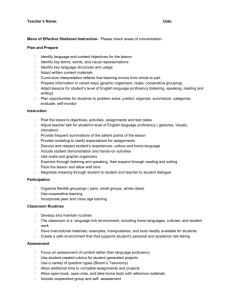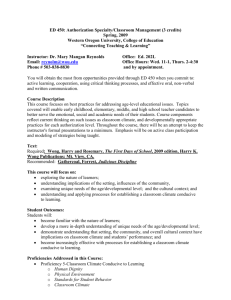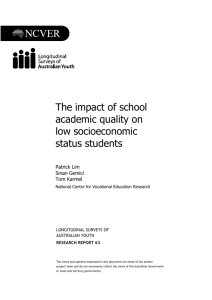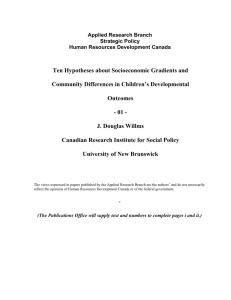Li_AmyLu - Academic Commons
advertisement
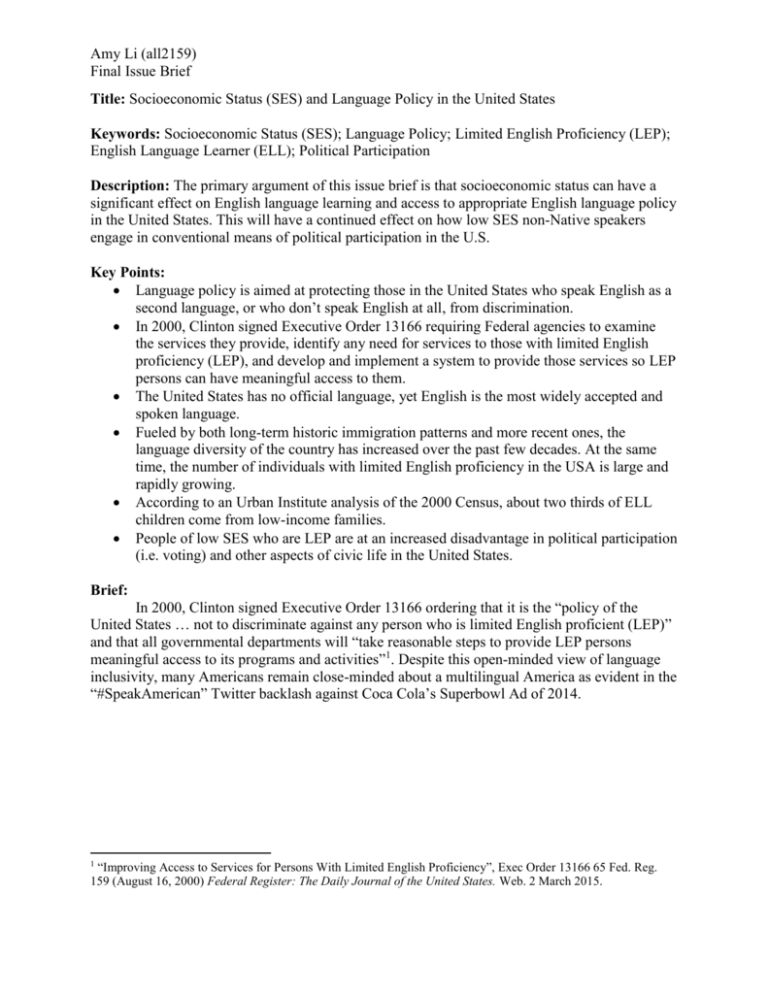
Amy Li (all2159) Final Issue Brief Title: Socioeconomic Status (SES) and Language Policy in the United States Keywords: Socioeconomic Status (SES); Language Policy; Limited English Proficiency (LEP); English Language Learner (ELL); Political Participation Description: The primary argument of this issue brief is that socioeconomic status can have a significant effect on English language learning and access to appropriate English language policy in the United States. This will have a continued effect on how low SES non-Native speakers engage in conventional means of political participation in the U.S. Key Points: Language policy is aimed at protecting those in the United States who speak English as a second language, or who don’t speak English at all, from discrimination. In 2000, Clinton signed Executive Order 13166 requiring Federal agencies to examine the services they provide, identify any need for services to those with limited English proficiency (LEP), and develop and implement a system to provide those services so LEP persons can have meaningful access to them. The United States has no official language, yet English is the most widely accepted and spoken language. Fueled by both long-term historic immigration patterns and more recent ones, the language diversity of the country has increased over the past few decades. At the same time, the number of individuals with limited English proficiency in the USA is large and rapidly growing. According to an Urban Institute analysis of the 2000 Census, about two thirds of ELL children come from low-income families. People of low SES who are LEP are at an increased disadvantage in political participation (i.e. voting) and other aspects of civic life in the United States. Brief: In 2000, Clinton signed Executive Order 13166 ordering that it is the “policy of the United States … not to discriminate against any person who is limited English proficient (LEP)” and that all governmental departments will “take reasonable steps to provide LEP persons meaningful access to its programs and activities”1. Despite this open-minded view of language inclusivity, many Americans remain close-minded about a multilingual America as evident in the “#SpeakAmerican” Twitter backlash against Coca Cola’s Superbowl Ad of 2014. 1 “Improving Access to Services for Persons With Limited English Proficiency”, Exec Order 13166 65 Fed. Reg. 159 (August 16, 2000) Federal Register: The Daily Journal of the United States. Web. 2 March 2015. Amy Li (all2159) Final Issue Brief *screenshots from Twitter This is surprising given the fact the number of non-English speakers has been rising rapidly. According to a census report published in 2013, several languages or language groups experienced major growth between 2000 and 2011, which include groups comprising mostly of South Asian languages (Malayalam, Telugu, Tamil, Punjabi, Bengali, and Hindi), “African languages,” (Amharic, Ibo, Yoruba, and Swahili), and Spanish languages.2 Additionally, the number of limited proficiency English speakers is rapidly growing (21.4 million in the U.S. as of 2009)3. Furthermore, it is largely agreed that English is the “predominant language used in social discourse and in business transactions, and the ability to communicate in English is thus linked with success in adjusting to life in America”4. Furthermore, sociolinguists suggest that English language proficiency is not just important but also necessary for participation in increasingly formal social domains5. As such, it is important to 2 U.S. Census Report: “Language Use in the United States: 2011.” American Community Survey Reports. Leiyu S, Lebrun LA, Tsai J. The influence of English proficiency on access to care. Ethnicity and Health. 2009;14:625–642. 4 Milton Gordon. 1964. “The Nature of Assimilation” (Ch. 3 pp60-83) in Assimilation in American Life. New York: Oxford University Press. 5 Kieffer, M. J. "Socioeconomic Status, English Proficiency, and Late-Emerging Reading Difficulties." Educational Researcher: 484-86. Print. 3 Amy Li (all2159) Final Issue Brief determine the ease at which populations – specifically those of low SES – within the U.S. have access to English language learning. In a study conducted by Snow et al, findings show that “low socioeconomic status (SES) is known to put students at elevated risk for early difficulties”6 in English language learning. Then, since the English language is a large component in terms of success in “participation in increasingly formal social domains”, people of lower socioeconomic status are at a significant disadvantage. A most glaring disadvantage that people of limited English proficiency face is in access to healthcare. According to a study conducted by Sentell, Shumway, & Snowden in 20077, language barriers remain a critical unsolved obstacle to mental health services where much of diagnosis and treatment relies on verbal and private communication8. Furthermore, according to an Urban Institute analysis of the 2000 Census, “about two thirds of ELL children come from low-income families” (Capps et al, 2005)9 and children of immigrant families from lower socioeconomic status may face a disadvantage since they are equipped with fewer resources10 – resources including access to English language support. In 2000, 68 percent of ELLs in grades pre K–5 and 60 percent in grades 6–12 lived in low-income families, compared with 36 percent and 32 percent, respectively, of Englishproficient students in these age groups. ELL students at high-poverty schools acquired English more slowly than students at other schools11. This is significant as it shows that socioeconomic status may contribute to the relatively low performance of English language learners12. As such, it is clear that those of lower socioeconomic status are at a significant disadvantage in learning English. Furthermore, more research needs to be done in the effects of SES and access to specific language policy outcomes – perhaps most importantly in healthcare – in order to better map out a way to include low SES populations in US political life. 6 Ibid Sentell, Tetine, Martha Shumway, and Lonnie Snowden. "Access To Mental Health Treatment By English Language Proficiency And Race/Ethnicity."Journal of General Internal Medicine: 289-93. Print. 8 Sentell T., Shumway M., Snowden L. (2007). Access to mental health treatment by English language proficiency and race/ethnicity. Journal of General Internal Medicine, 22(Suppl 2), 289–293. 9 Garcia, Eugene, Bryant Jensen, and Kent Scribner. "The Demographic Imperative." Educational Leadership 1 Apr. 2009: 8-13. Print. 10 Turney K, Kao G. Assessing the private safety net: social support among minority immigrant parents. The Sociological Quarterly.2009;50(4):666–692. 11 Garcia, Eugene, Bryant Jensen, and Kent Scribner. "The Demographic Imperative." Educational Leadership 1 Apr. 2009: 8-13. Print. 12 Ibid 7




